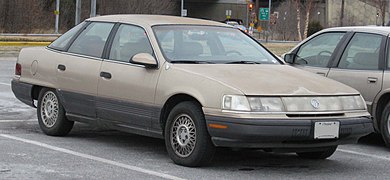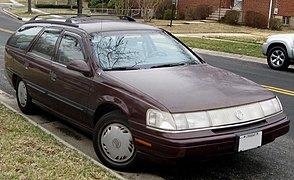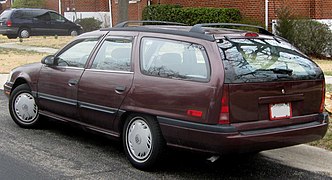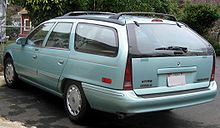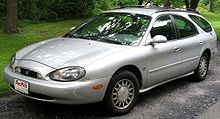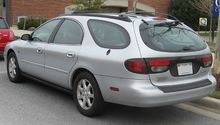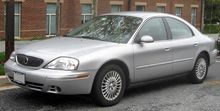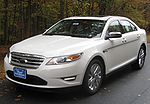Mercury Sable
| Mercury Sable | |
|---|---|
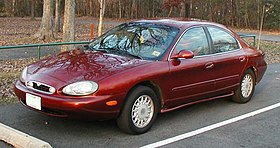 | |
| Overview | |
| Manufacturer | Mercury (Ford) |
| Production |
|
| Model years | 1986–2005 2008–2009 |
| Body and chassis | |
| Class | Mid-size car (1986–2005) Full-size car (2008–2009) |
| Chronology | |
| Predecessor | Mid-size: Mercury Marquis Full-size: Mercury Montego |
| Successor | Ford Taurus Limited (indirect) |
The Mercury Sable is a range of automobiles that were manufactured and marketed by the Mercury brand of Ford Motor Company. Introduced on December 26, 1985 as the replacement for the Mercury Marquis, the Sable marked the transition of the mid-size Mercury product range to front-wheel drive.
For its entire production life, the Sable served as the Mercury counterpart of the Ford Taurus (no Sable equivalent of the Taurus SHO was ever produced), slotted below the Grand Marquis. From the 1986 to 2005 model years, the Sable was produced as a mid-size vehicle; four-door sedan and five-door station wagon body styles were offered. For 2006, the Sable was withdrawn, replaced by the full-size Montego and mid-size Milan. For 2008, the Sable was reintroduced as a full-size car, offered solely as a four-door sedan.
Due to declining sales, the Sable was discontinued after the 2009 model year, leaving no Mercury counterpart of the sixth-generation Taurus. The final Sable was produced on May 21, 2009; in total, 2,112,374 Sables were produced during its 1985–2005 production.[2][3]
The Mercury Sable nameplate was derived from the sable, a weasel-like mammal from Russia that is valued for its smooth, dark fur.
Background[edit]
In early 1980, the Mercury Sable began development alongside the Ford Taurus; the $3.5 billion project would become the largest development ever undertaken by Ford at the time.[4][5][6] Originally intended to replace its full-size and mid-size rear-wheel drive product lines (Panther and Fox platforms, respectively), the Taurus/Sable were focused toward the mid-size segment in 1981 (the company felt stabilization of gasoline prices justified the continuation of its full-size model lines).[5] The Taurus was to replace the Ford LTD while the Sable replaced the Mercury Marquis.[6]
While designed entirely in North America, the Taurus/Sable were designed under a similar approach as the Ford Escort, using an interdisciplinary team approach; each element of the vehicle was designed concurrently, including manufacturing and assembly.[4] Along with input from potential buyers (in stark contrast to the Edsel), Ford used reverse engineering of competitive vehicles as a design input tool.[6]
During the development of the Sable, Mercury had become one of the final American brands to adopt front-wheel drive into its vehicle line. In 1982, as a sedan/station wagon version of the Chevrolet Citation, General Motors produced the quartet of the Chevrolet Celebrity/Pontiac 6000/Oldsmobile Cutlass/Buick Century; a year later, Chrysler expanded its K cars into the mid-size segment with the first front-wheel drive Chrysler New Yorker.[7] Coinciding with the 1986 launch of the Sable, General Motors downsized Buick, Oldsmobile, and Pontiac full-size sedans to front-wheel drive, only slightly larger than the mid-size Sable.
For 1983, Mercury underwent a brand revision, with the Cougar reverting to its traditional role as a two-door personal coupe alongside the Ford Thunderbird; while retaining the same chassis underpinnings, the Thunderbird and Cougar underwent a complete exterior redesign, becoming the first Ford cars produced with highly aerodynamic designs, a central objective of the Taurus/Sable design.[8][9] The 1983 Cougar was well received in the marketplace (outselling the 1983 Thunderbird[8]); Ford would choose to abandon "boxy" car design altogether, influencing other car manufacturers to follow suit during the 1980s.[7] Following the Thunderbird and Cougar, Ford introduced the 1984 Ford Tempo and Mercury Topaz. The compact front-wheel drive replacements for the Ford Fairmont/Mercury Zephyr, the Tempo/Topaz marked the first use of aerodynamic body design by Ford for a sedan.
First generation (1986–1991)[edit]
| First generation | |
|---|---|
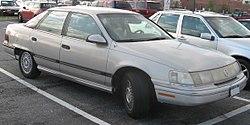 | |
| Overview | |
| Also called | Ford Taurus (Mexico) Kia sable (South Korea) |
| Production | October 1985 – 1991 |
| Assembly | United States: |
| Designer | Jack Telnack |
| Body and chassis | |
| Body style | 4-door sedan 5-door station wagon |
| Layout | FF layout |
| Platform | Ford DN5 Platform |
| Related | Ford Taurus LINCOLN Continental |
| Powertrain | |
| Engine | 2.5 L HSC I4 3.0 L Vulcan V6 3.8 L Essex V6 |
| Transmission | 3-speed ATX automatic 4-speed AXOD automatic |
| Dimensions | |
| Wheelbase | 106 in (2,692 mm) |
| Length |
|
| Width | 70.8 in (1,798 mm) |
| Height | 54.3 in (1,379 mm) (sedan) 55.1 in (1,400 mm) (station wagon) |
In mid-1985, Ford unveiled the Mercury Sable alongside the Ford Taurus as a 1986 model. In place of a traditional auto show unveiling, the launch was held an MGM Studios soundstage (where Gone with the Wind was filmed). Ford workers came into the room, which was decorated in space-age decor, holding cups shaped like flying saucers and the Taurus and Sable were sitting behind a curtain. With the flashing of strobe lights and a drum-roll, the curtain was pulled back and the two cars were revealed to the public.[7]
Replacing the mid-size Marquis (Cougar prior to 1983) sedan and station wagon, to protect its investment, Ford produced both model lines for the 1986 model year.[6] While it would not outsell its Taurus counterpart, the Sable would prove successful during its production, competing with the Grand Marquis as the highest-selling Mercury model line. As the Mercury brand was not sold in Mexico, Ford of Mexico marketed the Sable as the Ford Taurus.
The Sable was on Car and Driver magazine's Ten Best list on its release in 1986 and again in 1990 and 1991.[10]
Chassis specification[edit]
The first-generation Sable used the front-wheel drive Ford DN5 platform, sharing its 106-inch wheelbase with the Ford Taurus. As with its Marquis predecessor, the Sable used unibody construction. The Sable is equipped with four-wheel independent suspension.[11] The front axle is fitted with MacPherson struts and a stabilizer bar; the rear axle on sedans is a coil-sprung 4-link layout with a coil-sprung double-wishbone (short/long arm) for station wagons, along with a stabilizer bar.[11] As with the Marquis, the Sable was equipped with front disc brakes and rear drum brakes; station wagons were fitted with larger rear brakes.[11]
Powertrain[edit]
For the first year on the market, Sable buyers had the choice of a 90 hp HSC 4-cylinder mated to a three-speed automatic transaxle or a 140 hp Vulcan V6 with a four-speed automatic, with the latter having much higher sales. 4-cylinder Sable sales were so poor that the engine was dropped in 1987 (it remained an option for the Taurus until 1991). Ford's 3.8 L Essex V6 was added to the line-up in 1988. Although the power output was rated at the same 140 hp (104 kW) as the 3.0 L engine, this large V6 produced 215 ft·lbf (291 N·m) of torque, a welcome addition, especially in the heavier station wagons. However, the 3.8 suffered from premature head gasket failure, which was primarily a fault with Ford's supplier of gaskets, not with the engine itself. Some also attribute this to reduced under-hood cooling.[10] Unlike the Taurus, no manual transmission was offered in the Sable.
| Model | Engine | Year | Power | Torque | Transmission |
|---|---|---|---|---|---|
| GS | 2.5 L CFI HSC I4 | 1986 | 90 hp (67 kW) | 130 ft·lbf (176 N·m) | 3-speed ATX automatic |
| GS | 3.0 L SFI Vulcan V6 | 1986–1991 | 140 hp (104 kW) | 160 ft·lbf (217 N·m) | 4-speed AXOD automatic (1986–90) 4-speed AXOD-E automatic (1991) |
| LS | |||||
| GS | 3.8 L SFI Essex V6 | 1988–1991 | 140 hp (104 kW) | 215 ft·lbf (291 N·m) | |
| LS |
Body design[edit]
The first-generation Sable was offered in two body styles: a four-door sedan and a five-door station wagon. In an extensive departure from its Marquis predecessor, the Sable sedan shares only its doors and roof stamping with the Taurus. To differentiate its roofline, the B, C, and D-pillars of the Sable sedan were blacked out for a "floating roof" effect.[12] In a design that would be adapted by the Mercury Topaz and Tracer (and other automakers in the early 1990s),[13][14] a low-wattage "lightbar" was fitted between the headlamps. The lightbar design element further showcased the lack of a conventional grille, a design pioneered by the Citroën DS and shared with the Ford Mustang SVO and Ford Sierra.[7] Alongside the Taurus, the Sable was the first American-produced sedan to use aerodynamic composite headlights with replaceable halogen bulbs; to begin their use, Ford (and other auto manufacturers) lobbied the National Highway Traffic Safety Administration (NHTSA) to have them approved, with the 1984 Continental Mark VII becoming the first American car to use them.[7]
During its production, the first-generation Sable underwent few changes. For 1989, the exterior underwent a mid-cycle revision; the amber parking lamp lenses were replaced by clear units and sedans saw revisions to taillamp lenses.
While sharing largely the same features as the Taurus interior, in a departure from tradition, the Sable was designed with a separate interior, with a dashboard as part of the door panels.[10] In sedans, six-passenger seating was standard, with optional front bucket seats reducing capacity to five.[10] In station wagons, a two-passenger rear-facing third-row seat was an option (the first mid-size Mercury station wagon to do so since the 1977 Cougar).[10][15] For 1990, the Sable underwent a redesign of the dashboard to accommodate the addition of a driver-side airbag; a CD player was added as an option.[10]
Trim[edit]
The first-generation Mercury Sable was sold in two trim levels, in line with other Mercury models: base-trim GS and top-trim LS. As the first-generation Sable was never sold with a manual transmission, there was no equivalent to the Taurus MT-5 or Taurus SHO.[10]
Second generation (1992–1995)[edit]
| Second generation | |
|---|---|
 | |
| Overview | |
| Production | 1991–1995 |
| Assembly | Atlanta, Georgia Chicago, Illinois |
| Designer | Jack Telnack |
| Body and chassis | |
| Body style | 4-door sedan 4-door station wagon |
| Layout | FF layout |
| Platform | Ford DN5 Platform |
| Related | Ford Taurus LINCOLN Continental Ford Windstar |
| Powertrain | |
| Engine | 3.0 L Vulcan V6 3.8 L Essex V6 |
| Transmission | 4-speed AXOD-E/AX4S automatic 4-speed AX4N automatic |
| Dimensions | |
| Wheelbase | 106.0 in. |
| Length | 192.2 in. (sedan) 193.2 in. (wagon) |
| Width | 71.2 in. |
| Height | 54.4 in. (sedan) 55.5 in. (wagon) |
For the 1992 model year, the second-generation Sable was introduced. As part of a $650 million investment in the Taurus and Sable, both model lines received significant updates, focusing on the interior and front and rear fascias.[10] In contrast to the previous Sable, Ford chose an evolutionary change for the model line; though visibly similar to the previous generation, every body panel on the Sable sedan (except the doors) was changed.[16] On the station wagon (shared with both the Sable and Taurus), the front fascia was redesigned, along with the interior.
The interior of the Sable underwent a redesign of the door panels, dashboard, and interior controls.[16] Following the 1990 addition of a driver-side airbag, the Sable gained a passenger-side airbag as an option for 1992 (becoming standard in 1993).[16] For 1993, the steering wheel was redesigned (returning the horn to the center of the steering wheel).[16]
The base "GS" and luxury "LS" trim levels were carried over from the previous generation. A front cloth bench seat was standard on GS sedans and wagons, although cloth bucket seats were available on GS sedans only. Higher-end cloth bucket seats were standard on LS sedans, but a bench seat was a no cost option. A front bench was standard on LS wagons, with bucket seats optional. Leather seating surfaces were available on all LS Sables.
In 1992 for MY 1993, unpopular optional features such as the "InstaClear" heated windshield were eliminated.[16] For 3.0 L V6 engines, the drive belt system became a single-belt setup for 1993 (previously, the 3.0 L alternator had used a separate belt).[16] Also some 3.0 L 1994 models began receiving the new AX4N transmission.
The wagon version was available with mostly the same options as the sedan versions.[16] Wagons had a maximum of 81.1 cubic feet of cargo area with the 60/40 split rear seat folded down.[17] They featured a 2-way liftgate (raise the entire liftgate or just the window), a roof rack with crossbar and tie-downs, an optional rear-facing third seat, a lockable under-floor compartment, and an optional fold-out picnic table. With both rear split seats in the upright position, standard cargo capacity was 45.7 cubic feet.[16] Wagons that were equipped with the front bench seat and rear folding seat could seat eight people; while over two feet shorter than the 1991 Mercury Colony Park, the Sable wagon became the sole eight-passenger vehicle offered by LINCOLN-Mercury (as the Mercury Villager minivan seated seven).
1995 was the final model year of the second-generation Sable; the rare LTS trim level was added. It featured leather bucket seats, Taurus LX-style alloy wheels, special cladding, and many leather wrapped interior trim parts.[16] The LTS trim had either the standard 3.0 L Vulcan V6 or the optional 3.8 L Essex V6.
Models[edit]
| Model | Year | Transmission | Engine | Power | Torque |
|---|---|---|---|---|---|
| GS LS |
1992–1995 | 4-speed AXOD-E (AX4S) automatic 4-speed AX4N automatic (some 1994-95) |
3.0 L SFI Vulcan V6 | 140 hp (104 kW) | 160 ft·lbf (217 N·m) |
| LTS | 1995 | ||||
| 3.8 L Essex V6 | 140 hp (104 kW) | 215 ft·lbf (291 N·m) |
Third generation (1996–1999)[edit]
| Third generation | |
|---|---|
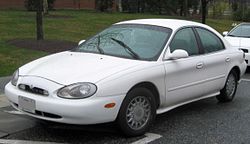 | |
| Overview | |
| Production | June 1995 – 1999 |
| Assembly | Atlanta, Georgia Chicago, Illinois |
| Designer | Jack Telnack |
| Body and chassis | |
| Body style | 4-door sedan 4-door station wagon |
| Layout | FF layout |
| Platform | Ford DN101 platform |
| Related | Ford Taurus LINCOLN Continental Ford Windstar |
| Powertrain | |
| Engine | 3.0 L Vulcan V6 3.0 L Duratec V6 |
| Transmission | 4-speed AX4N automatic |
| Dimensions | |
| Wheelbase | 108.5 in. |
| Length | 199.7 in. (sedan) 199.1 in. (station wagon) |
| Width | 73.0 in. |
| Height | 55.4 in. (sedan) 57.6 in. (station wagon) |
The third-generation Sable was introduced for the 1996 model year.[18] The platform used for the previous two generations underwent an extensive revision, redesignated as the DN101 platform; the wheelbase was extended from 106 to 108.5 inches. As before, the Sable returned as a four-door sedan and five-door station wagon.
While mechanically identical to its Ford Taurus counterpart, the sedans of the two model lines shared less sheetmetal than before, with only the front doors, hood, and front fenders common between the Taurus and Sable (as before, the Sable served as the basis for Ford and Mercury station wagons). In contrast to the oval-influenced roofline of the Ford Taurus, the Sable was styled with a sloped roofline with a rectangular rear window; the model received its own front and rear fascias.[18] In place of the long-running lightbar, the Sable received a chrome-trimmed grille (in line with the Mystique) with oval headlight housings.[18] In a design first for the model line, the Sable was fitted with the same interior as the Taurus (with the exception of seat fabrics).[10]
The trim lines saw a minor revision, with the Sable G introduced as a new entry-level model and the Sable LTS discontinued.[18] The Sable G was offered solely as a sedan, with several standard power options (but only an AM/FM radio[18]). For higher sales volumes, the GS and LS made their return, offered both in sedan and station wagon form. For the Sable G and GS, the standard engine was the 3.0L Vulcan V6, producing 145 hp. For the Sable LS, the standard engine was a 3.0L DOHC Duratec V6, producing 200 hp[19]; optional in the Sable GS, the Duratec engine was an enlarged version of the engine from the Mercury Mystique.
For 1997, the Sable underwent several cost-cutting revisions; several features of the LS became available on the GS as options.[10][18] For 1998, the Sable underwent a mid-cycle revision, distinguished by new headlights and a centered Mercury emblem in the grille; the Sable G was discontinued.[10][18] The Vulcan V6 engine became standard on all Sables, with the Duratec optional only on the LS for 1999.[18] In an effort to stimulate sales, Mercury cut the price of the Sable by up to $2,000 for 1999 (by revising the availability of options).[19][20]
Models[edit]
| Model | Year | Engine | Power | Torque | Transmission |
|---|---|---|---|---|---|
| G |
1996–1997 | 3.0 L SFI Vulcan V6 | 145 hp (108 kW) | 170 ft·lbf (244 N·m) | 4-speed AX4S automatic 4-speed AX4N automatic |
| 3.0 L DOHC Duratec 30 V6 | 200 hp (149 kW) | 200 ft·lbf (264 N·m) | |||
| LS | 1996–1999 | ||||
| GS | 1996–1999 | 3.0 L SFI Vulcan V6 | 145 hp (108 kW) | 170 ft·lbf (244 N·m) | |
| 3.0 L DOHC Duratec 30 V6 | 200 hp (149 kW) | 200 ft·lbf (264 N·m) |
Fourth generation (2000–2005)[edit]
| Fourth generation | |
|---|---|
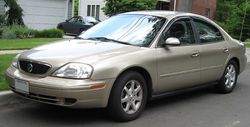 | |
| Overview | |
| Production | 1999–2005 |
| Assembly | Atlanta, Georgia Chicago, Illinois |
| Body and chassis | |
| Body style | 4-door sedan 4-door station wagon |
| Layout | FF layout |
| Platform | Ford D186 platform[21] |
| Related | Ford Taurus LINCOLN Continental |
| Powertrain | |
| Engine | 3.0 L Vulcan V6 3.0 L Duratec V6 |
| Transmission | 4-speed AX4N automatic |
| Dimensions | |
| Wheelbase | 108.5 in. |
| Length | 197.8 in. (station wagon) 199.8 in. (sedan) |
| Width | 73.0 in. |
| Height | 57.8 in. (station wagon) 55.5 in (sedan) |
| Chronology | |
| Successor | Mercury Milan Mercury Montego |
The Sable received another redesign in 1999 for MY 2000, which minimized some of the oval design elements from the 1996 model, replacing them with more conventional styling.[22] The redesign also featured a taller roof over the rear-passenger space, to increase passenger headroom that had been sacrificed by the tapered 1996 design.[22] The taller and roomier trunk also served to make the vehicle more functional.[10] The interior was completely changed for a much more conservative design.[22] Certain elements of the interior were retained from the 1996 model, such as the integrated control console, which combined the sound system and climate controls into one panel; but the shape of that panel was changed from the controversial oval to a more conventional and conservative trapezoid. The suspension was also softened to appeal to a broader, non-sporting audience.[22] To reduce the price and increase profitability, many features such as four-wheel disc brakes were eliminated [22] on the sedan; station wagons retained four-wheel disc brakes.
The 2002 Sable included extra equipment on every trim level, including a CD player and power driver's seat on the GS, and a power moonroof or leather interior on the LS.[10] Side airbags and traction control were added as options on all models.[10] For 2004, the Sable received minor cosmetic changes to the front and rear fascias, most noticeably the grille was made fully chrome. Inside were a new instrument cluster and steering wheel.[22]
Due to the Mercury brand's discontinuation in Canada, the fourth generation Sable was never available in the Canadian market. Thus it was unique to the US and Mexico.
The 2005 Mercury Montego and 2006 Milan were launched as replacements for the Sable.[22] Shortly after the Montego's introduction the Sable was discontinued, along with the Taurus wagon; the Taurus sedan continued to be produced, but primarily for the fleet market. The last Sable left the Atlanta plant on April 29, 2005.[23]
Models[edit]
| Model | Year | Engine | Power | Torque | Transmission |
|---|---|---|---|---|---|
| GS | 2000–2005 | 3.0 L SFI Vulcan V6 | 155 hp (116 kW) | 185 ft·lbf (251 N·m) | 4-speed AX4N automatic |
| 3.0 L DOHC Duratec 30 V6 | 200 hp (149 kW) | 195 ft·lbf (350 N·m) | |||
| LS |
Fifth generation (2008–2009)[edit]
| Fifth generation | |
|---|---|
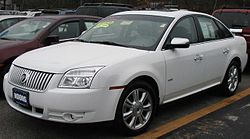 | |
| Overview | |
| Production | 2007-2009 |
| Assembly | Chicago, Illinois |
| Designer | J Mays |
| Body and chassis | |
| Body style | 4-door sedan |
| Layout | Front engine, front-wheel drive / four-wheel drive |
| Platform | Ford D3 platform |
| Related | LINCOLN MKS Volvo S60 Volvo XC90 Ford Taurus Ford Taurus X Ford Flex |
| Powertrain | |
| Engine | 3.5 L Cyclone V6 |
| Transmission | 6-speed 6F automatic |
| Dimensions | |
| Wheelbase | 112.9 in |
| Length | 202.1 in |
| Width | 74.5 in |
| Height | 61.5 in |
| Curb weight | 3643 lb (FWD) 3814 lb (AWD) |
| Chronology | |
| Predecessor | Mercury Montego |
| Successor | Ford Taurus |
The fifth-generation Mercury Sable was launched for the 2008 model year. Developed as a mid-cycle update of the Mercury Montego, the production vehicle revived the more widely-recognized Sable nameplate at the 2007 Chicago Auto Show.[24] While the 2008 revival of the Ford Taurus (renaming the Five Hundred) largely ended retail sale of the Crown Victoria, the Sable remained slotted below the Grand Marquis in the Mercury model line.
While approximately 10 inches shorter and 500 pounds lighter than the Grand Marquis, the fifth-generation Sable was the first produced as a full-size car. For the first time, the model line was offered exclusively as a four-door sedan (no Mercury counterpart of the Taurus X wagon was developed). Front-wheel drive remained standard, with all-wheel drive becoming an option for the first time.
In the transition to the Montego to the Sable, a number of changes were made to the body and chassis. Alongside the addition of the 263 hp 3.5L V6 and 6-speed 6F automatic, the exterior underwent several revisions, including a new front bumper and grille, redesigned headlamps; the LED taillamps were retained, but given white lenses. The fifth-generation Sable adopted the trim lines of the Montego and Milan, with an unnamed standard trim level and a top Premier trim.
Models[edit]
| Model | Year | Engine | Power | Torque | Transmission |
|---|---|---|---|---|---|
| Base Premier |
2008-2009 | 3.5 L Cyclone V6 | 263 hp | 265 ft·lbf | 6-speed 6F automatic |
Special editions[edit]
A few rare special editions of the Sable were made, all consisting of first generation models.
During MY 1987, Mercury introduced a special edition of the Sable called the "LS Monochrome Edition", which as an option would color the bumpers, side trim, and wheels white.[25] It was only offered during MY 1987; the production quantity is not known and it is also unknown how many still exist.[25]
During MY 1989, Mercury created a "50th Anniversary" edition of the Sable, to celebrate Mercury's 50th Anniversary. Keeping with the name, only 50 were sold, combined between GS and LS models. This Sable was actually a test bed for creating a Luxury sports version of the Sable called the LTS, similar to that of the Ford Taurus SHO. It was meant to use the SHO's chassis, interior, and suspension, but not the engine.[26] After the launch of the SHO, and all the publicity and praise it got, Ford shelved the Sable LTS to focus on the SHO, and because they were afraid it would take sales away from the SHO. The Sable LTS remained in a "development hell" until mid-1994 when it was introduced as a high end version of the Sable, but by then, it was just a highly optioned LS. An unknown number of these Sables still exist, but a pristine condition GS in this trim was sold on eBay in 2007.[26]
A special one-of-a-kind Sable convertible was created in 1987 for the 1988 Detroit SAE auto show. It was built from a sedan chassis and featured a completely custom two-door body with a custom folding top. However, it was shelved; the only one sat in a warehouse for years until it was given a VIN, titled, and driven. It was sold on eBay in 2006.[27]
In an article in Automotive News (circa 1990) an all aluminum "body in white" was made for a Sable. In an accompanying photo it is shown being held up by two middle aged women, leading to the belief it would weigh less than 600 lbs. At the time Audi had just released the A8, so it might have been an engineering exercise for constructing all aluminum frames, as Jaguar has now. Whatever became of the "Aluminum Sable Unibody", or if there was more than one, is unknown.
References[edit]
- "Taurus Car Club of America". Retrieved 2006-05-16.
- "Taurus/Sable Specifications". Taurus/Sable Encyclopedia. Retrieved 2007-07-06.
- Beadle, Tony (August 1996). The American Automobile. Smithmark Publishers. ISBN 0-8317-6267-5.
- Gunnell, John (July 2002). Standard Catalog of Ford 1903-2003 (3rd ed.). Krause Publications. ISBN 0-87349-452-0.
- http://www.leftlanenews.com/ford-taurus-x-mercury-sable-to-cease-production-next-year.html "Ford Taurus X, Mercury Sable to cease production next year (2009)".
Notes[edit]
- ^ https://www.nytimes.com/1985/12/01/magazine/ford-puts-its-future-on-the-line.html
- ^ Hoffman, Bryce G (May 17, 2009). "Sable reaches end of the line". The Detroit News. Retrieved 2009-05-18.
- ^ "Production Figures". Taurus/Sable Encyclopedia. Taurus Car Club of America. Retrieved 2009-09-25.
- ^ Jump up to: a b News, Dallas Morning. "TAURUS BRINGS TEAM APPROACH TO FORD". chicagotribune.com. Retrieved 2019-05-25.
- ^ Jump up to: a b Hartley, John R. (2017-09-20). Concurrent Engineering: Shortening Lead Times, Raising Quality, and Lowering Costs. Routledge. ISBN 9781351458351.
- ^ Jump up to: a b c d "Cars of Futures Past – 1986 Ford Taurus". www.hemmings.com. Retrieved 2019-05-25.
- ^ Jump up to: a b c d e Taub, Eric (November 1991). Taurus: The Making of the Car That Saved Ford. E. P. Dutton. ISBN 0-525-93372-7.
- ^ Jump up to: a b "Cool Cats: The 1983 Mercury Cougar". coolcats.new. 16 February 2005. Archived from the original on 27 April 2007. Retrieved 2007-03-18.
- ^ "How Mercury Cars Work". HowStuffWorks. 2007-06-06. Retrieved 2019-05-25.
- ^ Jump up to: a b c d e f g h i j k l m n DiPetro, John (2003-04-18). "Inside Line: Ford Taurus/Mercury Sable". Edmunds. Archived from the original on 2005-06-25. Retrieved 2019-05-25.
- ^ Jump up to: a b c "1988 Mercury Sable Brochure". www.oldcarbrochures.com. Retrieved 2019-05-25.
- ^ "How Mercury Cars Work". HowStuffWorks. 2007-06-06. Retrieved 2019-05-25.
- ^ Pontiac Grand Prix at Consumer Guide Archived 2007-10-15 at the Wayback Machine
- ^ Mitsubishi Eclipse at Consumer Guide Archived 2007-03-09 at the Wayback Machine
- ^ "1988 Mercury Sable Brochure". www.oldcarbrochures.com. Retrieved 2019-05-25.
- ^ Jump up to: a b c d e f g h i "Taurus/Sable spotters guide (Generation 2)". taurusclub.com/encyclopedia. Archived from the original on 2006-11-19. Retrieved 2007-03-18.
- ^ "1990-1995 Ford Taurus Review". Consumer Guide. Archived from the original on 2007-03-28. Retrieved 2007-02-13.
- ^ Jump up to: a b c d e f g h "Generation 3 - 1996 to 1999 | Taurus/Sable Encyclopedia". web.archive.org. 2017-07-20. Retrieved 2020-01-25.
- ^ Jump up to: a b "1996-1999 Mercury Sable at Consumer Guide". consumerguide.howstuffworks.com. Archived from the original on 2007-08-23. Retrieved 2007-08-17.
- ^ "Taurus/Sable spotters guide (Generation 3 1996-1999)". taurusclub.com/encyclopedia. Retrieved 2007-03-18.
- ^ https://europe.autonews.com/node/334356/
- ^ Jump up to: a b c d e f g "2000-2005 Mercury Sable". Consumer Guide. Archived from the original on 2007-02-10. Retrieved 2007-02-13.
- ^ Mayne, Eric (2005-04-19). "End of Ford Taurus closes era". Detroit News. Archived from the original on 2012-07-30. Retrieved 2006-05-16.
- ^ "Mercury Sable Returns to Showrooms With More Power, Style and Sophistication". Media. Ford.com. Archived from the original on 2007-09-27. Retrieved 2007-02-07.
- ^ Jump up to: a b "Generation 1 Spotter's Guide". Taurus/Sable Encyclopedia. Taurus Car Club of America. Retrieved 2007-02-13.
- ^ Jump up to: a b "1989 50th Anniversary Mercury Sable". encyclopedia.taurusclub.com. Retrieved 2007-03-18.
- ^ "1988 Sable Convertible concept". www.taurusclub.com/encyclopedia. Retrieved 2007-03-18.
External links[edit]
| Wikimedia Commons has media related to Mercury Sable. |
- Mercury Sable official site
- FAQ Farm's Mercury Sable FAQ: wiki question and answer forum
- Taurus Car Club of America
- TCCA: Taurus/Sable Encyclopedia
| show « previous — Mercury passenger vehicle timeline, 1980–2011
|
|---|
.jpg)
